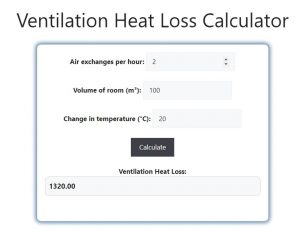About Ventilation Heat Loss Calculator (Formula)
A Ventilation Heat Loss Calculator is an essential tool for estimating the amount of heat lost through the ventilation system of a building. This is particularly useful for HVAC engineers and building managers looking to optimize energy consumption and maintain comfortable indoor temperatures. Proper ventilation is necessary, but it also introduces cold air, causing heat loss. Calculating this heat loss helps in designing efficient heating systems and reducing energy costs.
Formula
The formula to calculate ventilation heat loss is:
Heat Loss (Q) = 0.33 * n * V * ΔT
Where:
- Q is the heat loss in kilowatts (kW).
- n is the air change rate (the number of times the air in the room is replaced per hour).
- V is the volume of the room in cubic meters (m³).
- ΔT is the temperature difference between the inside and outside air (°C).
- 0.33 is a constant that converts the units.
How to Use
To use the Ventilation Heat Loss Calculator, follow these steps:
- Enter the air change rate (n): This is how many times the air in the room is replaced per hour.
- Input the room volume (V): Measure the room’s length, width, and height to calculate the volume in cubic meters (m³).
- Provide the temperature difference (ΔT): The difference between the inside temperature and the outside temperature in degrees Celsius.
- Press “Calculate,” and the calculator will return the total heat loss (Q) in kilowatts.
Example
Suppose a room has an air change rate of 2 per hour, a volume of 100 m³, and a temperature difference of 20°C. Using the formula:
Heat Loss (Q) = 0.33 * 2 * 100 * 20 = 1,320 kW
The heat loss due to ventilation is 1.32 kW.

FAQs
- What is ventilation heat loss?
Ventilation heat loss occurs when cold outside air enters a building, replacing warm inside air, causing heat to escape. - Why is it important to calculate ventilation heat loss?
Calculating ventilation heat loss helps you design efficient heating systems and reduce unnecessary energy consumption. - What is the air change rate?
The air change rate is the number of times per hour that the air in a room is completely replaced with fresh air. - How does room volume affect heat loss?
Larger room volumes result in higher heat loss because more air needs to be heated to maintain a comfortable temperature. - What does ΔT stand for?
ΔT represents the temperature difference between the inside and outside air. - Why is 0.33 used in the formula?
The constant 0.33 is used to convert the units in the heat loss calculation, making it compatible with typical HVAC measurements. - Can the Ventilation Heat Loss Calculator be used for any type of building?
Yes, the calculator can be used for residential, commercial, and industrial buildings as long as the required data is available. - How can I reduce ventilation heat loss?
You can reduce heat loss by improving insulation, using energy-efficient ventilation systems, and sealing air leaks. - Is there a difference in heat loss for natural vs. mechanical ventilation?
Yes, mechanical ventilation systems can be controlled more precisely, potentially reducing heat loss compared to natural ventilation. - How accurate is the heat loss calculation?
The accuracy depends on how accurately the inputs (air change rate, room volume, and temperature difference) are measured. - What is a typical air change rate for residential buildings?
For homes, the air change rate is usually between 0.5 and 1.5 air changes per hour, depending on insulation and ventilation systems. - Can this calculator help reduce energy bills?
Yes, by calculating heat loss, you can take steps to minimize it, improving energy efficiency and lowering heating costs. - What happens if the outside temperature changes frequently?
The heat loss will vary as ΔT changes, so the calculator provides an estimate based on the current or average temperature difference. - Does this calculator account for other forms of heat loss?
No, it only calculates heat loss due to ventilation. You need separate calculations for heat loss through walls, windows, and roofs. - Is there a way to improve ventilation without increasing heat loss?
Heat recovery ventilation systems can exchange indoor and outdoor air while minimizing heat loss, improving energy efficiency. - Can I use this calculator for large commercial buildings?
Yes, as long as you input the correct air change rate, room volume, and temperature difference, the formula works for any building size. - How does insulation impact ventilation heat loss?
Insulation doesn’t directly affect ventilation heat loss, but well-insulated spaces may require less frequent air changes, reducing overall heat loss. - What units should be used for temperature in the calculator?
Temperature difference should be input in degrees Celsius (°C). - What is the significance of the air change rate for different climates?
Colder climates generally require fewer air changes to minimize heat loss, while warmer climates may tolerate more frequent air changes. - Can I calculate heat loss for different rooms separately?
Yes, you can use the calculator for each room by inputting the specific air change rate, volume, and temperature difference for that space.
Conclusion
The Ventilation Heat Loss Calculator is an invaluable tool for determining how much heat is lost through a building’s ventilation system. By understanding and calculating ventilation heat loss, homeowners, building managers, and HVAC professionals can make better decisions regarding energy consumption, heating efficiency, and overall cost savings. Whether for a residential or commercial setting, this calculator helps optimize heating systems and improve energy efficiency.